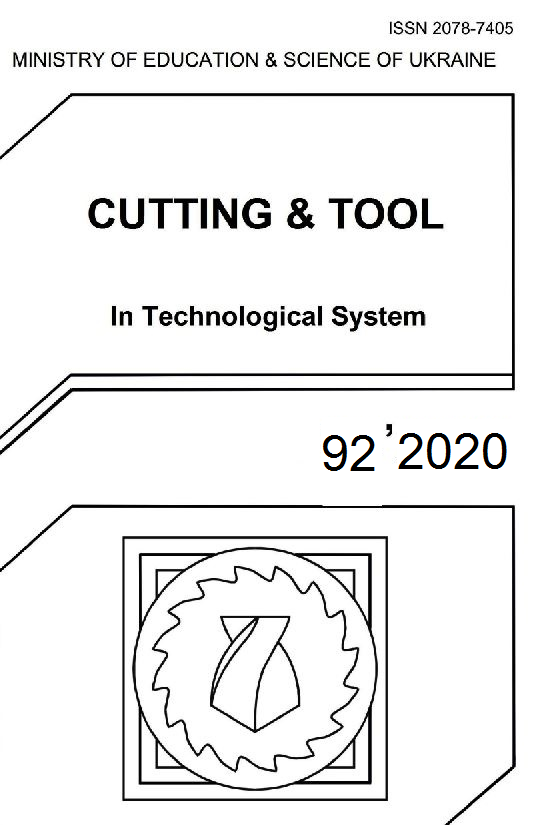WEAR GRINDING WHEELS WITH PRECISE WORKING SURFACE
DOI:
https://doi.org/10.20998/2078-7405.2020.92.21Keywords:
dimension wear, specific wear, intermittent grinding, steady grinding, creep feed (deep) grinding, cutting projections.Abstract
. The use of circles with an intermittent working surface is an effective means of increasing productivity and reducing the heat stress of the grinding process. These positive effects are largely determined by the appearance of high-frequency oscillations in the elastic system of the machine, which facilitate the chip formation process and create conditions for continuous self-formation of the cutting microrelief of the working surface of the abrasive tool. However, for certain aggregates of rigidity of the elastic system of the machine, geometric parameters of the macrorelief of the working surface of an intermittent circle, and parameters of the cutting mode, parametric resonance may occur, which is accompanied by catastrophic wear of an abrasive tool and a deterioration in the geometric and physical-mechanical characteristics of the quality of the surface layer of the workpiece. The aim of the work is to study the influence of grinding mode parameters and geometric parameters of the working surface of intermittent abrasive wheels on their dimensional and linear wear, as well as identifying areas of their rational use. It was found that oscillations during intermittent grinding caused by parametric resonance can be significantly reduced or eliminated completely by increasing the rigidity of the elastic system of the machine, using discontinuous circles of a certain geometry, and increasing the peripheral speed of the circle. Based on the experiments to determine the specific wear of the elbore dashed circles, the expediency of their use in deep encryption is substantiated. t is established that to increase dimensional stability of an abrasive tool it is necessary to increase the circular velocity to 40 m / s and to provide in the machines the possibility of preserving the constancy of the circular velocity of the circle as it is worn.References
Alekseev, N.S. Worn grinding wheels while processing microprecise covers. /N.S Alekseev // Proceedings of the universities. Mechanical Engineering. - 2004. - №2. pp. 57 - 61.
Belyakov, V.N. Evaluation of performance of abrasive tools /V.N. Belyakov, Y. Dubrovsky IV Shvetsov, OV Nikulenko // Tools and technology. - 2005. - № 21-22. pp. 28 -31.
Vorontsova, A.N. Investigation of the effect of magnitude of force acting on the wear of the grinding wheel during the grinding with constant force /A.N. Vorontsov, VV Vorontsov // News VUolgGTU. - 2004. --№ 9. pp. 12 -15.
Pazhitsky, E. A study of the radial wheel wear during the longitudinal grinding of external cylindrical surfaces / E. Pazhitsky // Proceedings of the International. Internet Conf. "Technological complexes, business equipment building materials and construction industry." - Minsk 2003.
Gutsalenko, Y.G. Ensuring the sustainability of diamond grinding /Y.G. Gutsaleko // Vіsn. Kharkiv. nats..techn. sіlsk the University. Gospa Island IM. Peter Vasilenko: ST. Sciences. etc. Kharkiv: HNTUST, 2006. - Vip.. 42. - pp. 246 -252.
Gutsalenko, Y.G. Resistance range in workflow management stable grinding // Vіsn. nat. techn. University the "Hark. polіtechn. іn.- t "- 2005. - №23. - pp.50-63.
Owl, A.N. Effect of wear on the grinding wheel precision mold profiles. / A.N. Owl // Chemical and petroleum engineering. - 1981. - №11. - pp. 27 - 28.
Filin, A.N. Improving the accuracy of profile shaped surfaces at the plunge grinding by stabilizing the radial tool wear: Author. Dis. ... Doctor. techn. Sciences: 05.02.08 / Mosk. Machine Tool Institute. - Moscow, 1987. – 33 p.
Yakіmov, O.O. Technological security of Quality surface ball racks high-precised gears at polishing: Author. Dis .... Doctor. techn. Sciences: 05.02.08 / Odes. nat. polіtehn. Univ. - Odessa, 2015. – 50 p.
Gun’ko, N.I. Investigation of the effect of rigidity on surface grinding machines grinding wheels wear during interrupted grinding /N.I. Gun'ko // numerical processing methods: Sat. scientific. works. - Perm: Perm Polytechnic. In - t, 1971. - Vol. 97. – pp. 3 - 8.
Yakimov, A.V. Deep grinding of parts of circles with intermittent kubonita worktop / AV. Yakimov, AK Rahmani, AA Yakimov // Diamonds and superhard materials: science and tech. abstract Collection. - Moscow .: Institute of diamond, 1983. - Vol. 3. - pp. 8 -11.
Klimenko, N.N. Improving the performance of the creation of the wear parts of the surface layer of titanium carbide clad: dis. ... Cand. tehn. Sciences .: 05.02.08 / Klimenko Natalia. - Odessa, 2003. - 233 p.
Downloads
Published
Issue
Section
License
Copyright Notice
Authors who publish with this Collection agree to the following terms:
1. Authors retain copyright and grant the Collection right of first publication with the work simultaneously licensed under a Creative Commons Attribution License that allows others to share the work with an acknowledgement of the work's authorship and initial publication in this Collection.
2. Authors are able to enter into separate, additional contractual arrangements for the non-exclusive distribution of the Collection's published version of the work (e.g., post it to an institutional repository or publish it in a book), with an acknowledgement of its initial publication in this Collection.
3. Authors are permitted and encouraged to post their work online (e.g., in institutional repositories or on their website) prior to and during the submission process, as it can lead to productive exchanges, as well as earlier and greater citation of published work.

